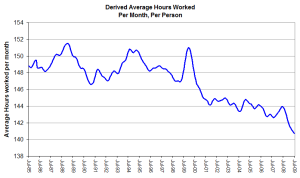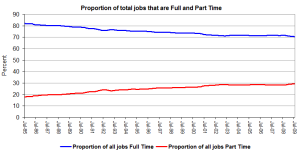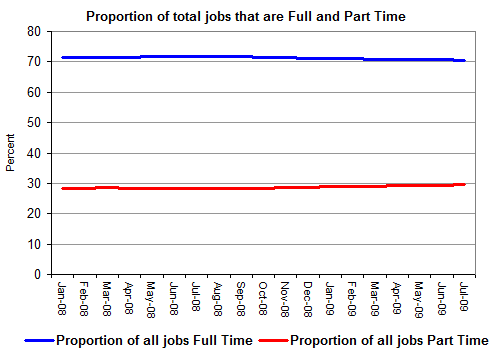The ABS has released a new series to accompany their Labour Force Survey results called Aggregate Monthly Hours Worked, which you can read all about over at the ABS site. It’s a nifty new series that the ABS describes as:
To complement the existing weekly actual hours worked original estimates, the ABS has developed estimates of aggregate monthly hours worked, available as seasonally adjusted and trend estimates. This measures the total number of hours worked by employed persons in a calendar month. The methodology used to produce aggregate monthly hours worked means that these are synthetic estimates. Seasonally adjusted and trend estimates of aggregate monthly hours worked are available for the period July 1985 onwards.
How many hours did the nation work in July?
Just over 1.5 billion hours in total – which is pretty amazing stuff when you think about it.
One of the nifty things about this new data is what it allows us to do. For instance, if we use the trend measure of aggregate hours and divide it by the trend measure of total employment numbers – we can derive an approximation of the average hours a given employee works in a month. It currently stands at 140.7 hours. But we can do more, we can actually track that figure across time from July 1985:
(click to expand)
As you can see, the average amount of hours worked per month per worker has been trending downwards for at least a decade, yet some of this can be explained by the changing proportions of both full and part time jobs in the economy. If we look at the proportion of all jobs in the economy that are full and part time, and track them over the same period we get:
Back in 1985, 82% of all jobs were full time, while only 18% of all jobs were part time.Yet today, that mix has changed significantly with only 70.5% of all jobs now being full time.
Yet that changing mix of jobs doesn’t fully explain what we see in that first graph – not statistically at least. Other things are afoot – probably a great, great many other things from workers and employers changing preferences, forced casualisation and increasing levels of flexibility in the labour market, right through to basic issues of changing labour demand. Over the next few months we should see some interesting third party research come out using this new data – research that should significantly add to our knowledge of just how the Australian labour market works in practice.
One final note – if we redo that first chart but just look at the period from January 2008 onwards, something interesting pops up.
Since June, average hours worked per employed person have been declining quite rapidly – adding considerable empirical weight to the argument that employers are choosing to reduce the hours of their workforce rather than lay people off, especially in light of how the full time/part time job mix over the same period hasnt really changed.
It’s a large part of the reason why our unemployment rate continues to remain low in the face of the global economic downturn – a rate which today came in unchanged at a seasonally adjusted 5.8%.
The details on the seasonally adjusted figures came in as:
Employment
-increased by 32,200 to 10,793,600. Full-time employment decreased by 16,000 to 7,590,400 and part-time employment increased by 48,200 to 3,203,200.Unemployment
-increased by 800 to 664,100. The number of persons looking for full-time work decreased by 4,800 to 495,900 and the number of persons looking for part-time work increased by 5,600 to 168,200.











Crikey is committed to hosting lively discussions. Help us keep the conversation useful, interesting and welcoming. We aim to publish comments quickly in the interest of promoting robust conversation, but we’re a small team and we deploy filters to protect against legal risk. Occasionally your comment may be held up while we review, but we’re working as fast as we can to keep the conversation rolling.
The Crikey comment section is members-only content. Please subscribe to leave a comment.
The Crikey comment section is members-only content. Please login to leave a comment.